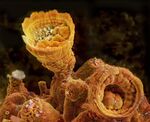Chemistry:Arsenic pentasulfide

| |
| Names | |
|---|---|
| IUPAC name
Arsenic pentasulfide
| |
| Other names
Arsenic(V) sulfide
Diarsenic pentasulfide | |
| Identifiers | |
3D model (JSmol)
|
|
| ChemSpider | |
| EC Number |
|
PubChem CID
|
|
| UNII | |
| UN number | 1557 |
| |
| |
| Properties | |
| As2S5 | |
| Molar mass | 310.14 g·mol−1 |
| Appearance | Vivid, dark orange, opaque crystals |
| Melting point | 300 °C (572 °F; 573 K)(minimum) |
| Boiling point | 500 °C (932 °F; 773 K)(decomposes) |
| 0.014 g dm−3 (at 0 °C) | |
| Hazards | |
| GHS pictograms |  
|
| GHS Signal word | Danger |
| H301, H331, H410 | |
| P261, P264, P270, P271, P273, P301+310, P304+340, P311, P321, P330, P391, P403+233, P405, P501 | |
| Related compounds | |
Related compounds
|
Arsenic pentoxide |
Except where otherwise noted, data are given for materials in their standard state (at 25 °C [77 °F], 100 kPa). | |
| Infobox references | |
Arsenic pentasulfide is an inorganic compound containing arsenic and sulfur.[1]
Uses
Solids of the approximate formula As2S5 have been used as pigments and chemical intermediates but are generally only of interest in academic laboratories.[2]
Preparation
Arsenic pentasulfide is prepared by precipitation from an acidic solution of soluble As(V) salts by treatment with hydrogen sulfide.[3] It may be also prepared by heating a mixture of arsenic and sulfur, extracting the fused mass with an ammonia solution and reprecipitating arsenic pentasulfide at low temperature by addition of hydrochloric acid.
Phosphorus pentasulfide with the formula P4S10, is a molecular compound featuring tetrahedral phosphorus(V) centres. Trends in arsenic redox potentials suggest that As2S5 adopts a similar structure, a plausible alternative being an arsenic polysulfide.
Reactions
Arsenic pentasulfide hydrolyzes in boiling water, giving arsenous acid and sulfur:
- As2S5 + 6 H2O → 2 H3AsO3 + 2 S + 3 H2S
It oxidizes in air at elevated temperatures producing arsenic oxides, the products and yields of which are variable. In alkali metal sulfide solutions arsenic pentasulfide forms a thioarsenate anion, [AsS4]3−, which contain As(V) centres.
References
- ↑ Greenwood, Norman N.; Earnshaw, Alan (1997). Chemistry of the Elements (2nd ed.). Butterworth-Heinemann. ISBN 978-0-08-037941-8.
- ↑ A. L. Emelina, A. S. Alikhanian, A. V. Steblevskii and E. N. Kolosov "Phase diagram of the As-S system" Inorganic Materials, 2007, Volume 43, pages95-104, doi:10.1134/S002016850702001X
- ↑ ed. by N. C. Norman. (1998). Chemistry of arsenic, antimony and bismuth. London: Blackie Acad. & Professional. pp. 114–115. ISBN 978-0-7514-0389-3. https://books.google.com/books?id=vVhpurkfeN4C&pg=PA114.
 |

